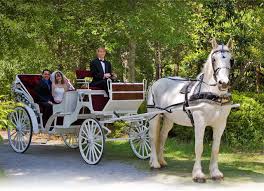A horse Drawn Carriage is a great way of transporting a bride to and from a venue
 A horse drawn carriage is a means of transport where a person or persons are pulled along by a horse on a large carriage with four large wheels, they were more widespread until the end of the nineteenth century until the advent and more widespread use of the automobile.
A horse drawn carriage is a means of transport where a person or persons are pulled along by a horse on a large carriage with four large wheels, they were more widespread until the end of the nineteenth century until the advent and more widespread use of the automobile.
The carriages were of different typology depending on the use for which they were used. Among the various specific designations exist such as the saloon, closed with representative function, the coupe also closed but with only two seats, the gig with an open top for the summer, the landau, with soft top or the most luxurious phaeton, comparable to Today's luxury convertible cars.
They were pulled by draft animals, usually by one or more horses depending on the type of the medium and its use. The driver was placed in a forward position or the back of the carriage in a housing raised from the carrier intended to accommodate passengers.
The carriages were first tested and exploited to the technologies that we find on modern cars, such as the suspension in crossbow to improve the comfort of travel for passengers.
The historical continuity between the coach and 'car is evidenced both by the fact that companies specialized in their construction have mostly continued activity in the field of new motor vehicles, and the fact that today most of the names used for define different types of body took the name from their progenitor.
The history of the carriage goes back centuries, already the prehistoric peoples and later the Roman civilization used animal-drawn carts. The use also continued in the Middle Ages, to a lesser extent.
However a first example of a closed carriage was designed and built in the twelfth century for the wedding of Galeazzo Visconti and Beatrice d'Este. Since that time the use of the carriage spread but remained the preserve of only the noble families; in this regard it would seem to testify that documents of Galeazzo Maria Sforza he owned a dozen.
In the middle of the fifteenth century came the fashion of Verona a cart that is closed with a single chest resting on the axis. Right in the fifteenth century by ' Hungary spread an innovative model which provided the bag suspended axis by belts and chains; this model took the name of the coach from the name of the Hungarian town of Kocs where it was invented.
In the sixteenth century they invented the first systems of spring suspension, but for a wide variety of reasons, including the poor roads, then created many inconveniences. If in France the carriage spread slowly and in 1500 in Paris, there were only three known instances, at the end of the century in England this vehicle was still unknown.
In Italy have a similar medium became a real fashion and, by the mid-sixteenth century, Ferrara became the most renowned international manufacturers.
In France, the coach became an indispensable means in the time of Louis XV and Louis XVI, when swept the fashion of the coupe a real evolution of the old guard.
In the seventeenth century, reflecting the influence Baroque, did not lack rich specimens adorned with sculptures when the improvement of roads favoured the development of the traveling coach, both public and private, thus increasing decorative simplicity of the medium.
According to reliable historical records the first coach of the modern interior with closed doors with glass was born in Berlin in 1670, invention of the architect Filippo Di Piedmont Churches. He was a clever designer who worked mainly for architectural projects including the castle of Klein-Glienicke and he was court architect in Potsdam, near Berlin, in the service of the Elector Frederick William of Brandenburg. On his behest Filippo Di Churches built this first model of car that, perhaps because of the proximity to the German capital, was called " sedan ".
Since then, the use of the carriage culminated with becoming the new symbol bourgeois with a widespread distribution throughout Europe and in the new world in many different versions. Also at the end of the seventeenth century, in Italy, Milan won the primacy of its spread with more than 1,600 sedans in circulation, forcing the authorities to formulate the first road regulations.
Get a quote for a wedding cake for your big day.
Wedding Cakes PricesFind the latest in elegegant wedding dresses made from lace.
Lace Wedding DressesStylish, traditional transport for your wedding day.
Horse Drawn CarriageGet hints and tips withsaving money for your wedding day with a bit of DIY.
DIY Wedding InvitationsSet a budget for your big day with a comprehensivebudget planner.
Weddings on a Budget